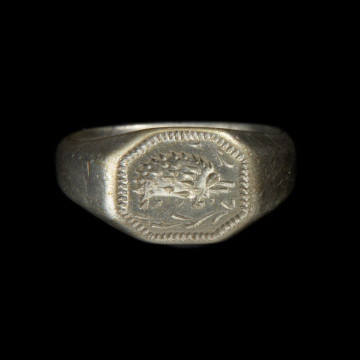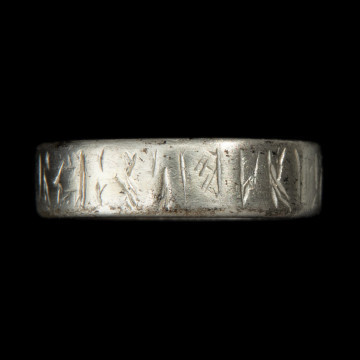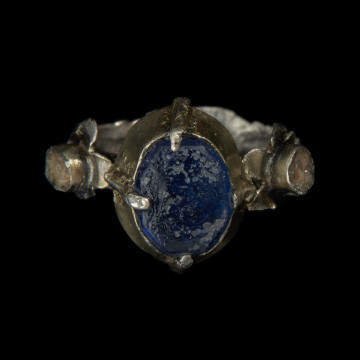
Signet ring with hedgehog
przełom XIV i XV wieku
National Museum in Szczecin
Part of the collection: Archaeological monuments of the Lublin region
The richly ornamented gold pendant is an excellent example of the high level of jewellery art from the first centuries AD.
It was made of electrum (electron), an alloy of gold and silver. The ornament was placed as a gift in the mortuary tomb of a warrior. The tomb was accidentally discovered in the 1950s by residents of Orońsk, in the Radom poviat, while digging sand from a dune near the Oronka River. Unfortunately, the discoverers partially destroyed the object. However, they reported the discovery to the conservator's office in Lublin.The archaeologists Jan Gurba and Zygmunt Ślusarski, who came to the site, registered a disturbed grave cavity in which there was a javelin arrowhead driven vertically and a pendant lying next to it. Apart from these relics the following items belonged to the equipment of the grave: earthenware vessels, among them an ashtray in which burnt human bones were placed, an iron sword ritually bent into a hoop, a fragment of a clasp, an iron wheel, a knife, scissors and a clay spinning wheel. The presence of a sword and a spearhead indicates that this is a burial of a warrior, while the types of weapons allow dating the tomb to the 2nd half of the 2nd century AD.
The most interesting relic from this group is undoubtedly the electron ball pendant. Its body is decorated with four vertical ribs, between which are diagonally arranged fields of punch points. The body is attached to a pendant with an eyelet made of a band decorated with granulation. An additional decoration is the element crowning the bottom of the spherical body. It has the form of a sleeve with a soldered cone, whose top and four corners are decorated with triads of granules.
Ball pendants are relatively rare finds in the territory of Central European Barbaricum. In Orońsko, the ornament is accompanied by male tomb furnishings, which makes this monument extremely interesting. Above all, it is an extremely valuable exhibit, unique for the nature of the bullion from which it was made, and an excellent example of the finesse of ancient goldsmiths, who were already familiar with the techniques of filigree and granulation.
Author / creator
Dimensions
cały obiekt: height: 20 mm, diameter: 5 mm
Object type
jewelry
Technique
filigree
Material
Electrum
Creation / finding place
Owner
The National Museum in Lublin
Identification number
Location / status

przełom XIV i XV wieku
National Museum in Szczecin

przełom XIV i XV wieku
National Museum in Szczecin

National Museum in Szczecin
DISCOVER this TOPIC
Museum of King Jan III's Palace at Wilanów
DISCOVER this PATH
Educational path